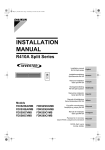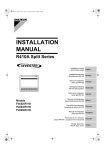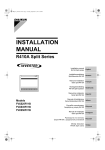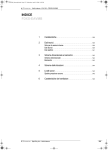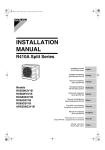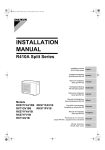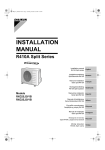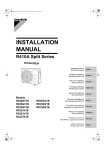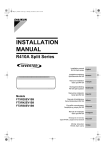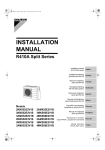Download Daikin FDKS25EAVMB Installation manual
Transcript
00_CV_3P132003-3N.fm Page 1 Wednesday, November 29, 2006 6:40 PM INSTALLATION MANUAL R410A Split Series Installation manual R410A Split series Installationsanleitung Split-Baureihe R410A Deutsch Manuel d’installation Série split R410A Français Montagehandleiding R410A Split-systeem Manual de instalación Serie Split R410A Models FDXS25EAVMB FDXS35EAVMB FDXS50CVMB FDXS60CVMB Manuale d’installazione Serie Multiambienti R410A FDKS25EAVMB FDKS35EAVMB FDKS50CVMB FDKS60CVMB English Εγχειρßδιο εγκατÜστασηò διαιροýìενηò σειρÜò R410A Manual de Instalação Série split R410A Рóêоводство по монтажó Серия R410A с раздельной óстановêой R410A Split serisi montaj elkitabý Nederlands Español Italiano ΕλληνικÜ Portugues Рóссêий Türkçe Daikin.TCF.015 74736-KRQ/EMC97-4957. Daikin.TCF.015 74736-KRQ/EMC97-4957. Daikin.TCF.015 74736-KRQ/EMC97-4957. Daikin.TCF.015 74736-KRQ/EMC97-4957. Daikin.TCF.015 74736-KRQ/EMC97-4957. Daikin.TCF.015 74736-KRQ/EMC97-4957. Daikin.TCF.015 74736-KRQ/EMC97-4957. Daikin.TCF.015 74736-KRQ/EMC97-4957. Daikin.TCF.015 74736-KRQ/EMC97-4957. FDXS25EAVMB, FDXS35EAVMB, FDXS50CVMB, FDXS60CVMB, FDKS25EAVMB, FDKS35EAVMB, FDKS50CVMB, FDKS60CVMB DAIKIN INDUSTRIES, LTD. 3P132004-3E Noboru Murata Manager Quality Control Department Shiga, 1st of Oct. 2005 Daikin.TCF.015 74736-KRQ/EMC97-4957 Daikin.TCF.015 74736-KRQ/EMC97-4957. Daikin.TCF.015 74736-KRQ/EMC97-4957. Daikin.TCF.015 74736-KRQ/EMC97-4957 Daikin.TCF.015 74736-KRQ/EMC97-4957. Daikin.TCF.015 74736-KRQ/EMC97-4957. 74736-KRQ/EMC97-4957. Daikin.TCF.015 Daikin.TCF.015 Daikin.TCF.015 74736-KRQ/EMC97-4957. 74736-KRQ/EMC97-4957. Daikin.TCF.015 Daikin.TCF.015 74736-KRQ/EMC97-4957. Umeda Center Bldg., 4-12, Nakazaki-Nishi 2-chome, Kita-ku, Osaka, 530-8323 Japan Daikin.TCF.015 74736-KRQ/EMC97-4957. Daikin.TCF.015, 74736-KRQ/EMC97-4957. Daikin.TCF.015 74736-KRQ/EMC97-4957. Daikin.TCF.015 74736-KRQ/EMC97-4957 74736-KRQ/EMC97-4957. 74736-KRQ/EMC97-4957. Daikin.TCF.015 01_EN_3P132003-3N.fm Page 1 Tuesday, December 5, 2006 1:29 PM SAFETY PRECAUTIONS • Read these Safety Precautions carefully to ensure correct installation. • This manual classifies the precautions into WARNING and CAUTION. Be sure to follow all the precautions below: they are all important for ensuring safety. WARNING...............Failure to follow any of WARNING is likely to result in such grave consequences as death or serious injury. CAUTION...............Failure to follow any of CAUTION may in some cases result in grave consequences. • The following safety symbols are used throughout this manual: Be sure to observe this instruction. Be sure to establish an earth connection. Never attempt. • After completing installation, test the unit to check for installation errors. Give the user adequate instructions concerning the use and cleaning of the unit according to the Operation Manual. WARNING • Installation should be left to the dealer or another professional. Improper installation may cause water leakage, electrical shock, or fire. • Install the air conditioner according to the instructions given in this manual. Incomplete installation may cause water leakage, electrical shock, or fire. • Be sure to use the supplied or specified installation parts. Use of other parts may cause the unit to come to lose, water leakage, electrical shock, or fire. • Install the air conditioner on a solid base that can support the weight of the unit. An inadequate base or incomplete installation may cause injury in the event the unit falls off the base. • Electrical work should be carried out in accordance with the installation manual and the national electrical wiring rules or code of practice. Insufficient capacity or incomplete electrical work may cause electrical shock or fire. • Be sure to use a dedicated power circuit. Never use a power supply shared by another appliance. • For wiring, use a cable length enough to cover the entire distance with no connection. Do not use an extension cord. Do not put other loads on the power supply, use a dedicated power circuit. (Failure to do so may cause abnormal heat, electric shock or fire.) • Use the specified types of wires for electrical connections between the indoor and outdoor units. Firmly clamp the interconnecting wires so their terminals receive no external stresses. Incomplete connections or clamping may cause terminal overheating or fire. • After connecting interconnecting and supply wiring be sure to shape the cables so that they do not put undue force on the electrical covers or panels. Install covers over the wires. Incomplete cover installation may cause terminal overheating, electrical shock, or fire. • When installing or relocating the system, be sure to keep the refrigerant circuit free from substances other than the specified refrigerant (R410A), such as air. (Any presence of air or other foreign substance in the refrigerant circuit causes an abnormal pressure rise or rupture, resulting in injury.) • If any refrigerant has leaked out during the installation work, ventilate the room. (The refrigerant produces a toxic gas if exposed to flames.) • After all installation is complete, check to make sure that no refrigerant is leaking out. (The refrigerant produces a toxic gas if exposed to flames.) • During pump-down, stop the compressor before removing the refrigerant piping. If the compressor is still running and the shut-off valve is open during pump-down, air will be sucked in when the refrigerant piping is removed, causing abnormal pressure in the freezer cycle which will lead to breakage and even injury. • During installation, attach the refrigerant piping securely before running the compressor. If the compressor is not attached and the shut-off valve is open during pump-down, air will be sucked in when the compressor is run, causing abnormal pressure in the freezer cycle which will lead to breakage and even injury. • When carrying out piping connection, take care not to let air substances other than the specified refrigerant go into refrigeration cycle. Otherwise, it will cause lower capacity, abnormal high pressure in the refrigeration cycle, explosion and injury. • Be sure to establish an earth. Do not earth the unit to a utility pipe, arrester, or telephone earth. Incomplete earth may cause electrical shock, or fire. A high surge current from lightning or other sources may cause damage to the air conditioner. • Be sure to install an earth leakage breaker. Failure to install an earth leakage breaker may result in electric shocks, or fire. CAUTION • Do not install the air conditioner in a place where there is danger of exposure to inflammable gas leakage. If the gas leaks and builds up around the unit, it may catch fire. • Establish drain piping according to the instructions of this manual. Inadequate piping may cause flooding. • Tighten the flare nut according to the specified method such as with a torque wrench. If the flare nut is tightened too hard, the flare nut may crack after a long time and cause refrigerant leakage. 1 English 01_EN_3P132003-3N.fm Page 2 Tuesday, December 5, 2006 1:29 PM ACCESSORIES Clamp metal Insulation for fitting 1 pc. 1 each Washer for Drain hose hanging bracket Sealing pad Large and small 3 pcs. 1 each (only for 50-60 type) 1 pc. Sealing material Clamp 2 pcs. 6 pcs. 8 pcs. 1 pc. Washer Screws for fixing plate duct flanges 1 set 1 set 4 pcs. 24 pcs. 2 large for gas pipe Large for liquid pipe Small Air fillter Hanger (right) 1 small insulation Stored in outlet vent Wireless Remote controller AAA remote controller holder dry-cell batteries 1 pc. 1 pc. 1 pc. Receiver kit 1 set 1 pc. 1 pc. Mounting frame Decorative cover [ Other ] 2 pcs. • Operation manual Screws M4 × 25 • Installation manual 2 pcs. CHOOSING A SITE • Before choosing the installation site, obtain user approval. Indoor unit Caution • When moving the unit during or after unpacking, make sure to lift it by holding its lifting lugs. Do not exert any pressure on other parts, especially the refrigerant piping, drain piping and flange parts. Wear protective gears (gloves and so on) when installing the unit. • If you think the humidity inside the ceiling might exceed 30°C and RH80%, reinforce the insulation on the unit body. Use glass wool or polyethylene foam as insulation so that the thickness is more than 10mm and fits inside the ceiling opening. Use suspension bolts to install the unit. Check whether or not the ceiling is strong enough to support the weight of the unit. If there is a risk that the ceiling is not strong enough, reinforce the ceiling before installing the unit. (Installation pitch is marked on the carton box for installation. Refer to it to check for points requiring reinforcing.) Select the *H dimension such that a downward slope of at least 1/100 is ensured as indicated in “DRAIN PIPING WORK”. • The installation pitch is listed on the packing material, and should be checked when deciding whether to reinforce the location or not. English 300 or more Maintenance space 20 or more Ceiling If there is no ceiling Control box *H= 2500 or more 240 or more Optimum air distribution is ensured. The air passage is not blocked. Condensate can drain properly. The ceiling is strong enough to bear the weight of the indoor unit. A false ceiling does not seem to be at an incline. Sufficient clearance for maintenance and servicing is ensured. Piping between the indoor and outdoor units is within the allowable limits. (Refer to the installation manual for the outdoor unit.) • The indoor unit, outdoor unit, power supply wiring and transmission wiring is at least 1 meter away from televisions and radios. This prevents image interference and noise in electrical appliances. (Noise may be generated depending on the conditions under which the electric wave is generated, even if a one-meter allowance is maintained.) 200 • • • • • • • Floor surface (length : mm) 2 01_EN_3P132003-3N.fm Page 3 Tuesday, December 5, 2006 1:29 PM CHOOSING A SITE Select the signal receiver mounting location according to the following conditions: • Install the signal receiver, which has a built-in temperature sensor, near the intake vent where there is convection of air and it can get an accurate reading of the room’s temperature. If the intake vent is in another room or the unit cannot be installed near the intake vent for any other reason, install it 1.5m above the floor on a wall where there is convection. • In order to get an accurate reading of the room’s temperature, install the signal receiver in a location where it is not exposed directly to cold or hot air from the air discharge grille or to direct sunlight. • Since the receiver has a built-in light receptor to receive signals from the wireless remote controller, do not mount it in a location where the signal may be blocked by a curtain, etc. Air discharge grille: Wooden or plastic grille is recommended because condensation may occur depending on humidity conditions. Caution If the signal receiver is not installed in a location where there is convection of air, it may be unable to get an accurate reading of the room’s temperature. Wireless remote controller • Turn on all the fluorescent lamps in the room, if any, and find the site where remote controller signals are properly received by the indoor unit (within 4 metres). Outdoor unit • For outdoor unit installation, see the installation manual supplied with the outdoor unit. PREPARATIONS BEFORE INSTALLATION Relation of the unit to the suspension bolt positions. 620 • Install the inspection opening on the control box side where maintenance and inspection of the control box are easy. Install the inspection opening also in the lower part of the unit. Air inlet 620 450×450 (Inspection opening size) Model 25 · 35 type 50 type 60 type (length: mm) A B 700 740 900 940 1100 1140 Install the suspension bolts. (Use W3/8 to M10 suspension bolts.) Use a hole-in-anchor, sunken insert, sunken anchor for existing ceilings, and a sunken insert, sunken anchor or other part to be procured in the field to reinforce the ceiling to bearing the weight of the unit. (Refer to Fig.) 〈SERVICE SPACE〉 A Control box Open the installation hole. (Pre-set ceilings) • Once the installation hole is opened in the ceiling where the unit is to be installed, pass refrigerant piping, drain piping, transmission wiring, and remote controller wiring (unneeded if using a wireless remote controller) to the unit’s piping and wiring holes.See “REFRIGERANT PIPING WORK”, “DRAIN PIPING WORK”, and “WIRING”. • After opening the ceiling hole, make sure ceiling is level if needed. It might be necessary to reinforce the ceiling frame to prevent shaking.Consult an architect or carpenter for details. B Air discharge Ceiling (Suspension bolt pitch ) (See the technical documentation for the range of the external static pressure setting.) (length : mm) Suspension bolt pitch A Make sure the range of the unit’s external static pressure is not exceeded. 500 Allow view Inspection door (Ceiling opening) Ceiling slab Anchor bolt Long nut or turn-buckle Suspension bolt Indoor unit Note: All the above parts are field supplied. 3 English 01_EN_3P132003-3N.fm Page 4 Tuesday, December 5, 2006 1:29 PM Mount chamber lid and air filter Protection net (1) (2) (accessory). Air inlet For bottom intake, replace the chamber lid and the protection net (only for 25-35 type) in the procedure listed in Fig. Chamber lid (1)Remove the protection net. Chamber lid Protection net (only for 25-35 type, 6 locations) Remove the chamber lid. (7 locations) Air discharge Air inlet Air discharge (2)Reattach the removed chamber lid in the orientation shown in Fig.(7 locations) Reattach the removed protection net in the orientation shown in Fig. (only for 25-35 type, 6 locations) Refer to Fig.for the direction of the protection net. (3)Attach sealing pad as shown in the figure below. (Stored in outlet vent) (only for 50-60 type) (In order to take in the air inside the ceiling, and when not taking in air from outdoor air, it is not necessary to stick.) • Attach the sealing pad (accessory) to Sealing pad (Small) Sealing pad (Small) the plate metal sections which are not (3) (accessory) (accessory) covered by anti-sweat material. Air inlet • Make sure there are no gaps between the different pieces of sealing pad. Air inlet Air discharge Sealing pad (Large) (accessory) Anti-sweat material included with the product Sealing pad (Large) (accessory) Air discharge Anti-sweat material included with the product For rear intake type For bottom intake type (4)Attach the hanger (right) insulation to the right hanger. (Stored in outlet vent) (See the below figure for the sticking base line.) Hanger bracket (right) Hanger (right) insulation Slit ine el as b ing ARROW VIEW ck Sti (5)Attach the air filter (accessory) in the manner shown in the diagram. In case of bottom side In case of back side Main unit Force Filter Force English Attach the filter to the main unit while pushing down on the bends. (2 bends for 25-35 type, 3 bends for 50-60 type) 4 01_EN_3P132003-3N.fm Page 5 Tuesday, December 5, 2006 1:29 PM PREPARATIONS BEFORE INSTALLATION When two indoor units are installed in one room, one of the two wireless remote controllers can be easily set for another addresses. PCB in the indoor unit • Cut the jumper JA on PCB. Wireless remote controller • Cut the jumper J4. 1 2 J4 3 Wireless remote controller JA ADDRESS JB JC ADDRESS: JA EXIST 1 CUT 2 J4 ADDRESS EXIST 1 CUT 2 INDOOR UNIT INSTALLATION 〈〈 As for the parts to be used for installation work, be sure to use the provided accessories and specified parts designated by our company. 〉〉 Install the indoor unit temporarily. • Attach the hanger bracket to the suspension bolt. Be sure to fix it securely by using a nut and washer from the upper and lower sides of the hanger bracket. (Refer to Fig.) [ Securing the hanger bracket ] [ How to secure washers ] Part to be procured in the field Washer for hanging bracket (accessory) [ PRECAUTION ] Since the unit uses a plastic drain pan, prevent welding spatter and other foreign substances from entering the outlet hole during installation. Hanger bracket Insert below washer Washer fixing plate (accessory) Tighten (double nut) Adjust the height of the unit. Check the unit is horizontally level. Level Vinyl tube Caution Make sure the unit is installed level using a level or a plastic tube filled with water.In using a plastic tube instead of a level ,adjust the top surface of the unit to the surface of the water at both ends of the plastic tube and adjust the unit horizontally.(One thing to watch out for in particular is if it is installed so that the slope is not in the direction of the drain piping,as this might cause leaking.) Tighten the upper nut. Mounting the receiver. Mount the receiver as shown below. 1 Press the receiver into the mounting frame. 2 Mount the completed assembly using two screws. 3 Press the decorative cover into the mounting frame. Note) Mount the Remote controller cord far enough away from strong electrical wires (such as distribution wires for electrical lights, air conditioners, etc.) and from weak electrical wires (such as wires for telephones, intercoms, etc.). 5 English 01_EN_3P132003-3N.fm Page 6 Tuesday, December 5, 2006 1:29 PM For heat pump: If your feet feel cold when using the heating function, it is recommended that the air discharge grille shown at below be attached. 45˚ (Adjustable angle) OUTDOOR UNIT INSTALLATION Install as described in the installation manual supplied with the outdoor unit. REFRIGERANT PIPING WORK See the installation manual supplied with the outdoor unit. 1. FLARING THE PIPE END 1) Cut the pipe end with a pipe cutter. 2) Remove burrs with the cut surface facing downward so that the chips do not enter the pipe. 3) Put the flare nut on the pipe. 4) Flare the pipe. 5) Check that the flaring is properly made. (Cut exactly at right angles.) Remove burrs Flaring Set exactly at the position shown below. A Die A Flare tool for R410A Conventional flare tool Clutch-type Clutch-type (Rigid-type) Wing-nut type (Imperial-type) 0-0.5mm 1.0-1.5mm 1.5-2.0mm Check Flare’s inner surface must be flaw-free. The pipe end must be evenly flared in a perfect circle. Make sure that the flare nut is fitted. Warning Do not use mineral oil on flared part. Prevent mineral oil from getting into the system as this would reduce the lifetime of the units. Never use piping which has been used for previous installations. Only use parts which are delivered with the unit. Do never install a drier to this R410A unit in order to guarantee its lifetime. The drying material may dissolve and damage the system. Incomplete flaring may cause refrigerant gas leakage. 2. REFRIGERANT PIPING 1) To prevent gas leakage, apply refrigeration machine oil on both inner and outer surfaces of the flare. (Use refrigeration oil for R410A) 2) Align the centres of both flares and tighten the flare nuts 3 or 4 turns by hand. Then tighten them fully with the torque wrenches. • Use torque wrenches when tightening the flare nuts to prevent damage to the flare nuts and escaping gas. Flare nut tightening torque Gas side 3/8 inch 1/2 inch 32.7-39.9N•m 49.5-60.3N•m (333-407kgf•cm) (505-615kgf•cm) Liquid side 1/4 inch 14.2-17.2N•m (144-175kgf•cm) Caution Overtightening may damage the flare and cause leaks. English 6 01_EN_3P132003-3N.fm Page 7 Tuesday, December 5, 2006 1:29 PM REFRIGERANT PIPING WORK 3) After the work is finished, make sure to check that there is no gas leak. Coat here with refrigeration machine oil Torque wrench Spanner Flare nut Piping union 4) After checking for gas leaks, be sure to insulate the pipe connections. • Insulate using the insulation for fitting included with the liquid and gas pipes. Besides, make sure the insulation for fitting on the liquid and gas piping has its seams facing up. (Tighten both edges with clamp.) • For the gas piping, wrap the medium sealing pad over the insulation for fitting (flare nut part). Gas Piping Insulation Procedure Piping insulation material (main unit) Attach to base Insulation for fitting (accessory) Flare nut connection Turn seams up Small sealing pad (accessory) Main unit Main unit Clamp (accessory) Liquid Piping Insulation Procedure Measure the length of the gas pipe as you will have to cover it with the sealing tape. Piping insulation material (Field supplied) Insulation for fitting (accessory) Piping insulation material (main unit) Flare nut connection Attach to base Liquid pipe Gas pipe Turn seams up Main unit Clamp (accessory) Wrap the sealing tape around the gas pipe. Piping insulation material (Field supplied) Caution Be sure to insulate any field piping all the way to the piping connection inside the unit. Any exposed piping may cause condensation or burns if touched. Cautions on Pipe Handling Wall Be sure to place a cap. • Protect the open end of the pipe against dust and moisture. (Tighten both edges with clamp.) • All pipe bends should be as gentle as possible. Use a pipe bender for bending. (Bending radius should be 30 to 40mm or larger.) Rain If no flare cap is available, cover the flare mouth with tape to keep dirt or water out. Selection of Copper and Heat Insulation materials When using commercial copper pipes and fittings, observe the following: • Insulation material: Polyethylene foam Heat transfer rate: 0.041 to 0.052W/mK (0.035 to 0.045kcal/mh°C) Refrigerant gas pipe’s surface temperature reaches 110°C max. Choose heat insulation materials that will withstand this temperature. • Be sure to insulate both the gas and liquid piping and to provide insulation dimensions as below. Gas side Gas pipe thermal insulation 25/35 class 50/60 class Liquid pipe thermal insulation I.D. 12-15mm I.D. 14-16mm I.D. 8-10mm Liquid side 25/35 class 50/60 class O.D. 9.5mm O.D. 12.7mm O.D. 6.4mm Thickness 0.8mm Also, when subject to high humidity, heat insulation of the refrigerant piping (the unit piping and branch piping) must be further reinforced. Reinforce the insulation when installing the unit near bathrooms, kitchens, and other similar locations. Refer to the following: • 30°C, more than 75% RH: 20mm Min. in thickness If the insulation is not sufficient, condensation may form on the surface of the insulation. • Use separate thermal insulation pipes for gas and liquid refrigerant pipes. 7 Thickness 10mm Min. Inter-unit wiring Gas pipe Gas pipe insulation Finishing tape Liquid pipe Liquid pipe insulation Drain hose English 01_EN_3P132003-3N.fm Page 8 Tuesday, December 5, 2006 1:29 PM DRAIN PIPING WORK Caution Make sure all water is out before making the duct connection. Install the drain piping. Drain pipe connection hole • Make sure the drain works properly. • The diameter of the drain pipe should be greater than or equal to the diameter of the connecting pipe (vinyl tube; pipe size: 20mm; outer dimension: 26mm). Refrigerant pipes Connect the drain pipe after removing the rubber cap and insulation tubing attached to the connection hole. • Keep the drain pipe short and sloping downwards at a gradient of at least 1/100 to prevent air pockets from forming. Caution Water accumulating in the drain piping can cause the drain to clog. • To keep the drain tube from sagging, space hanging wires every 1 to 1.5m. • Use the drain hose and the metal clamp. Insert the drain hose fully into the drain socket and firmly tighten the metal clamp with the upper part of the tape on the hose end. Tighten the metal clamp until the screw head is less than 4mm from the hose. • The two areas below should be insulated because condensation may form there causing water to leak. • Drain piping passing indoors Large sealing pad Clamp metal • Drain sockets (accessory) (accessory) Referring the figure below, insulate the metal clamp and drain hose using the Clamp metal included large sealing pad. (accessory) Tape Drain hose ≤4mm 〈 PRECAUTIONS 〉 Drain piping connections • Do not connect the drain piping directly to sewage pipes that smell of ammonia. The ammonia in the sewage might enter the indoor unit through the drain pipes and corrode the heat exchanger. • Do not twist or bend the drain hose, so that excessive force is not applied to it. (This type of treatment may cause leaking.) After piping work is finished, check drainage flows smoothly. • Gradually insert approximately 1L of water into the drain pan to check drainage in the manner described below. • Gradually pour approximately 1L of water from the outlet hole into the drain pan to check drainage. • Check the drainage. Air outlet Portable pump Bucket Refrigerant pipes Drain outlet English 8 01_EN_3P132003-3N.fm Page 9 Tuesday, December 5, 2006 1:29 PM INSTALLING THE DUCT Connect the duct supplied in the field. Air inlet side • Attach the duct and intake-side flange (field supply). • Connect the flange to the main unit with accessory screws (in 16, 20 or 24 positions). • Wrap the intake-side flange and duct connection area with aluminum tape or something similar to prevent air escaping. Caution When attaching a duct to the intake side, be sure also to attach an air filter inside the air passage on the intake side. (Use an air filter whose dust collecting efficiency is at least 50% in a gravimetric technique.) Outlet side • Connect the duct according to the inside of the outlet-side flange. • Wrap the outlet-side flange and the duct connection area with aluminum tape or something similar to prevent air escaping. Flange (Field supply) Main unit Connection screw (accessory) Flange Insulation material (Field supply) Aluminum tape (Field supply) Aluminum tape (Field supply) Air inlet side Outlet side Caution • Be sure to insulate the duct to prevent condensation from forming. (Material: glass wool or polyethylene foam, 25mm thick) • Use electric insulation between the duct and the wall when using metal ducts to pass metal laths of the net or fence shape or metal plating into wooden buildings. 9 English 01_EN_3P132003-3N.fm Page 10 Tuesday, December 5, 2006 1:29 PM WIRING See the installation manual supplied with the outdoor unit. HOW TO CONNECT WIRINGS. • Wire only after removing the control box lid as shown in the Fig. Control box lid • Make sure to let a wire go through a wire penetration area. • After wiring, seal the wire and wire penetration area to prevent moisture and small creatures from the outside. • Wrap the strong and weak electric lines with the sealing material as shown in the figure below. (Otherwise, moisture or small creatures such as insects from the outside may cause short-circuit inside the control box.) Attach securely so that there are no gaps. Power supply wiring Earth wire Wiring Diagram (Rear) ∗Remote controller wiring Sealing material (accessory) Wiring through hole (Control box side) Wiring Wire Clasp (Power supply side) Clamp (for fixing in place) (accessory) Outside unit Inside unit [How to adhere it] Caution • When clamping the wiring, use the included clamping material as shown in the Fig. to prevent outside pressure being exerted on the wiring connections and clamp firmly. • When doing the wiring, make sure the wiring is neat and does not cause the control box lid to stick up, then close the cover firmly. When attaching the control box lid, make sure you do not pinch any wires. • Outside the machine, separate the weak wiring (remote controller wiring) and strong wiring (earth wire and power supply wiring) at least 50mm so that they do not pass through the same place together. Proximity may cause electrical interference, malfunctions, and breakage. [ PRECAUTION ] • See also the “Electrical Wiring Diagram Nameplate” when wiring the unit for electrical power. [ Connecting electrical wiring ] Terminal block (4P) • Power supply wiring and Earth wire Power supply wiring Earth wire Remove the control box lid. Next, pull the wires into the unit through the wiring through hole and connect to the power wiring terminal block (4P). Be sure to put the part of the sheathed vinyl into the control box. Wiring through hole Indoor PCboard (ASSY) Power supply wiring Earth wire Clamp (for fixing in place) (accessory) Warning Do not use tapped wires, stand wires, extensioncords, or starbust connections, as they may cause overheating, electrical shock, or fire. To outdoor unit When wire length exceeds 10m, use 2.0mm wires. Indoor unit 1 2 3 1.6mm or 2.0mm H05VV English 10 01_EN_3P132003-3N.fm Page 11 Tuesday, December 5, 2006 1:29 PM TRIAL OPERATION AND TESTING Trial operation and testing (1) Measure the supply voltage and make sure that it falls in the specified range. (2) Trial operation should be carried out in either cooling or heating mode. Trial operation from remote controller (1) Press ON/OFF button to turn on the system. (2) Simultaneously press center of TEMP button and MODE button. (3) Press MODE button twice. (“ ” will appear on the display to indicate that Trial Operation mode is selected.) (4) Trial run mode terminates in approx. 30 minutes and switches into normal mode. To quit a trial operation, press ON/OFF button. For Heat pump. In cooling mode, select the lowest programmable temperature; in heating mode, select the highest programmable temperature. • Trial operation may be disabled in either mode depending on the room temperature. • After trial operation is complete, set the temperature to a normal level (26°C to 28°C in cooling mode, 20°C to 24°C in heating mode). • For protection, the system disables restart operation for 3 minutes after it is turned off. For Cooling only. Select the lowest programmable temperature. • Trial operation in cooling mode may be disabled depending on the room temperature. Use the remote control for trial operation as described below. • After trial operation is complete, set the temperature to a normal level (26°C to 28°C). • For protection, the unit disables restart operation for 3 minutes after it is turned off. (3) Carry out the test operation in accordance with the Operation Manual to ensure that all functions and parts, are working properly. * The air conditioner requires a small amount of power in its standby mode. If the system is not to be used for some time after installation, shut off the circuit breaker to eliminate unnecessary power consumption. * If the circuit breaker trips to shut off the power to the air conditioner, the system will restore the original operation mode when the circuit breaker is turned on again. Test items Test items Indoor and outdoor units are installed properly on solid bases. No refrigerant gas leaks. Refrigerant gas and liquid pipes and indoor drain hose extension are thermally insulated. Draining line is properly installed. System is properly earthed. The specified wires are used for interconnecting wire connections. Indoor or outdoor unit’s air inlet or discharge has clear path of air. Shut-off valves are opened. Indoor unit properly receives remote controller commands. 11 Symptom (diagnostic display on RC) Check Fall, vibration, noise Incomplete cooling/heating function Water leakage Water leakage Electrical leakage Inoperative or burn damage Incomplete cooling/heating function Inoperative English 00_CV_3P132003-3N.fm Page 2 Wednesday, November 29, 2006 6:40 PM Two-dimensional bar code is a code for manufacturing. 3P132003-3N M05B026C (0701) HT














